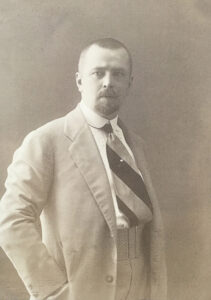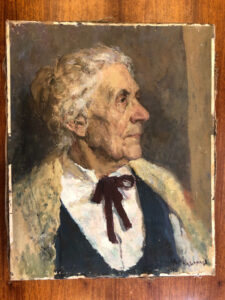Reshetnova Hanna
New biographical details about Oskar Hansen a hundred years after “disappearance”. Chinaware from the collection in the National Museum of Ukrainian Folk Decorative Art(NMUFDA).
Problem statement. Most museum collections are based on works from private collections. However, the personalities of collectors themselves are hardly ever mentioned, and the origin of worksare absent from the exposition cards in the majority of museums. Whereas such elimination ofindividuality was understandable during the Soviet period when many private collections werenationalized, in the 21st century when collecting history centers are set up in the developed countries, Ukrainian museums still do not do justice to art collectors.
One of such unjustly forgotten collectors was Oskar Hansen, who was not simply fond ofcollecting works of art – his collection served as the basis for the Third State Museum! Later, theworks were distributed among different Ukrainian museums, and Hansen’s history after the 1920s remained obscure. Almost a hundred years after the collector’s “disappearance”, we suggest hisbiography and collection in general should be thoroughly tracked.
The aim of this study is to publish new biographical details of Oskar Herman Hansen which the author has spent a lot of time researching; to provide unique, reliable information that has not been previously available to the art science community; to present part of chinaware from the National Museum of Ukrainian Folk Decorative Art that has been of the majestic collection of the Third State Museum.
The methodology of researching data about the personality of O. Hansen consisted in the abstraction and systemic analysis of the available archive sources and scientific articles dedicated to the collector’s biography. Using the simulation method, several hypotheses have been put forwardconcerning the ways of the protagonist’s “disappearance” – several theories were proposed and elaborated. The historical and cultural method was applied to understand the general historical pictureof the first quarter of the 20th century; the information method contributed to the rapid and efficient acquisition of facts and data from various sources. At the final stage, empirical methods such asinterviews, surveys, etc. were used.
In the process of working with the porcelain from Hansen’s collection kept in the NationalMuseum of Ukrainian Folk Decorative Art (NMUFDA), the art analysis method was used. Items wereclassified and quantified – porcelain was arranged and categorized according to the place ofmanufacture.
As a result of the present study, it was established and confirmed that Oskar Herman Hansen’sbiological father was famous Norwegian millionaire Herman Hansen nicknamed “Orange”, who moved to Saint Petersburg in the 1870s. Herman Hansen met Oskar’s mother Helena Wittersheim(previous Ukrainian studies mistakenly referred to Witterleim) in Warsaw, she was a Polish officer’s daughter. This well-established fact explains why O. Hansen chiefly paid attention to Polish art – not only his step-father, but also his mother were connected to Poland.
The author also establishes the reason why Oskar’s biological father’s name is absent fromUkrainian archive sources. Due to the big age disparity between Helena and Herman, their relationshipwas not officially registered. After an episode of infidelity, the civil family broke up, and the childrenwere separated: Karl remained with the father, and Oskar with the mother.
The most valuable contribution of this study is the rediscovery of Oskar Herman’s biographyafter his “disappearance” from Kyiv in the early 20th century. Thanks to Norwegian scholars, theauthor found O. Hansen’s granddaughter, and, based on her memoirs, the date and place of the famous collector’s death were published for the first time in Ukraine.
The article raises the question that no catalogue with Hansen’s works has been created almost ahundred year after the foundation of the Third State Museum. Enquires have been sent to museums totrace and retrieve the works from the museum by joint efforts. The National Museum of UkrainianFolk Decorative Art was among the first to agree; it reviewed and made an inventory of the chinaware that came from the Third State Museum by the place of manufacture.
Conclusions. In the article, the author has drawn a conventional genealogical line from OskarHarman Hansen’s father to his granddaughter, thus filling the gaps in the biographical data about the collector. As a result of this study, the life journey of the Third State Museum founder after the 1920s was traced. This information as well as the date and place of the collector’s death are published in this article for the first time.
With the help of museum staff, the author has outlined and categorized the chinaware fromNMUPFA owned by O. Hansen by the factory of manufacture. It will be described and investigated infurther studies.
It is hoped to structure and create a scientific catalogue of Oskar Herman Hansen’s complete collection including items from all Ukrainian museums.
Key words: Oskar Hansen, National Museum of Ukrainian Folk Decorative Art, Third State Museum, porcelain, private collection.

